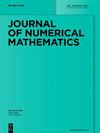用高阶元素解决二维/三维静态斯托克斯界面问题的弱 Galerkin 方案的分析与计算
IF 4
2区 数学
Q1 MATHEMATICS
引用次数: 0
摘要
本文提出了一种高阶弱 Galerkin 有限元方法 (WG-FEM),用于求解速度和压力在 ℝ d (d = 2, 3) 中不连续的斯托克斯静止界面问题。这种 WG 方法配备了稳定的有限元,其中速度由 k ≥ 1 阶的普通多项式组成,压力由 k - 1 阶的多项式组成,两者都是不连续的。在混合网格的 L 2 规范下,速度和压力的最佳收敛率分别为 k + 1 阶和 k 阶。数值实验验证了二维和三维实例的预期精度。此外,数值结果表明,所提出的 WG 算法能够适应具有尖锐边缘、尖角和尖端的复杂和非常不规则的几何界面。本文章由计算机程序翻译,如有差异,请以英文原文为准。
Analysis and Computation of a Weak Galerkin Scheme for Solving the 2D/3D Stationary Stokes Interface Problems with High-Order Elements
In this paper, we present a high-order weak Galerkin finite element method (WG-FEM) for solving the stationary Stokes interface problems with discontinuous velocity and pressure in ℝ d (d = 2, 3). This WG method is equipped with stable finite elements consisting of usual polynomials of degree k ≥ 1 for the velocity and polynomials of degree k – 1 for the pressure, both are discontinuous. Optimal convergence rates of order k + 1 for the velocity and order k for the pressure are established in L 2 -norm on hybrid meshes. Numerical experiments verify the expected order of accuracy for both two-dimensional and three-dimensional examples. Moreover, numerically it is shown that the proposed WG algorithm is able to accommodate geometrically complicated and very irregular interfaces having sharp edges, cusps, and tips.
求助全文
通过发布文献求助,成功后即可免费获取论文全文。
去求助
来源期刊
CiteScore
5.90
自引率
3.30%
发文量
17
审稿时长
>12 weeks
期刊介绍:
The Journal of Numerical Mathematics (formerly East-West Journal of Numerical Mathematics) contains high-quality papers featuring contemporary research in all areas of Numerical Mathematics. This includes the development, analysis, and implementation of new and innovative methods in Numerical Linear Algebra, Numerical Analysis, Optimal Control/Optimization, and Scientific Computing. The journal will also publish applications-oriented papers with significant mathematical content in computational fluid dynamics and other areas of computational engineering, finance, and life sciences.

 求助内容:
求助内容: 应助结果提醒方式:
应助结果提醒方式:


